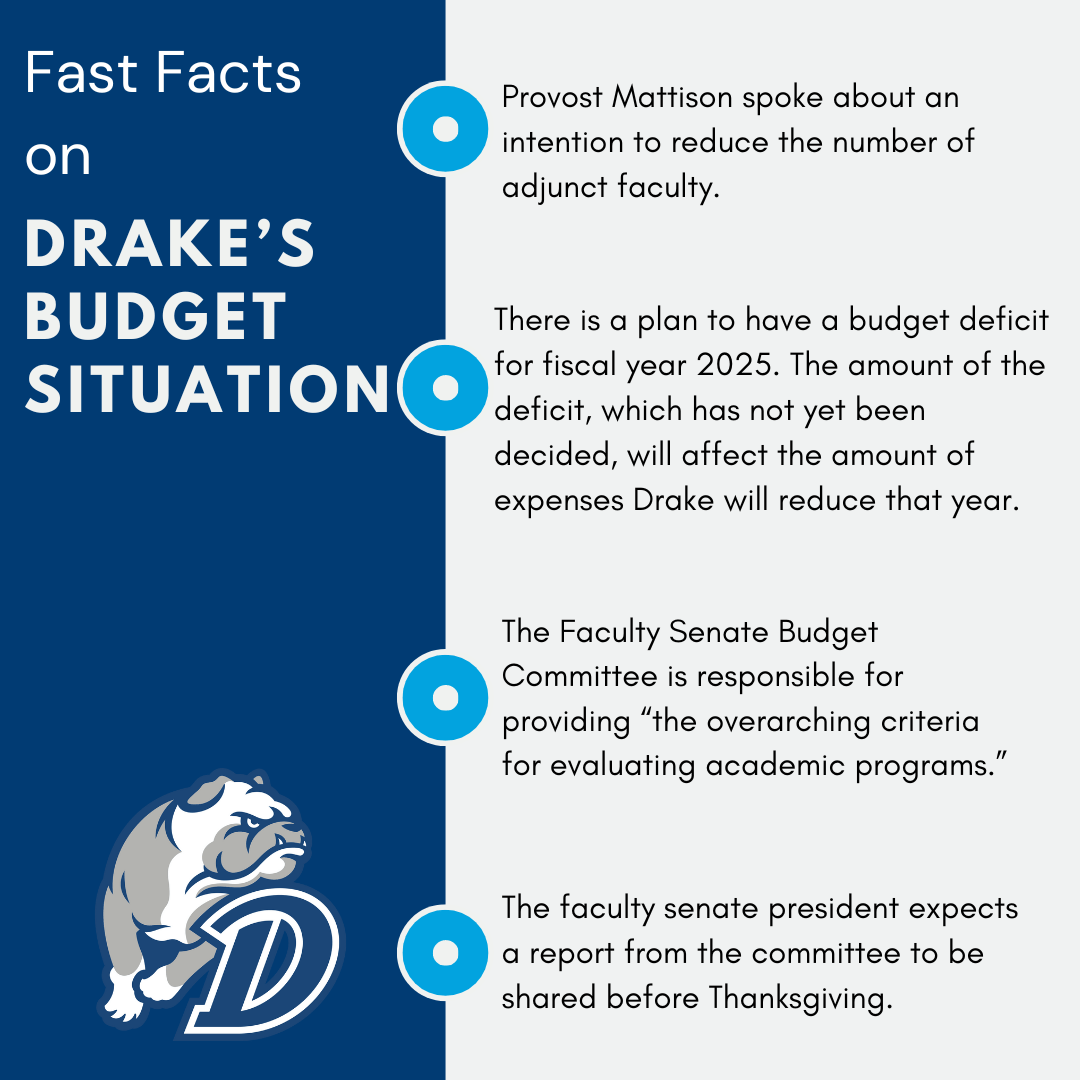During the Nov. 8 session of the Drake University Faculty Senate, Provost Sue Mattison said that Drake will see cuts to academic programs. It’s not yet clear which academic programs and faculty will be affected.
“It’s clear that the status quo is not an option,” Mattison said. “And eliminating programs and faculty lines is unavoidable.”
Mattison said the process of cutting programs will start by “streamlining the curriculum” to reduce overload courses and the number of adjunct faculty.
“Certainly we are not able to eliminate every adjunct role because there are some specialized expertise that add critical information to the curriculum for the students’ benefit,” Mattison said. “But to eliminate a good portion of the adjuncts by tightening the curriculum.”
Drake started the year with 616 entering first year students, Mattison said. An increase of 100 students would raise about $2 million — which isn’t enough to balance the budget.
Mattison’s goal is to ensure Drake is “strong and relevant” for the next 10, 50 and 100 years, she said.
“I am committed to transparency and communication and soliciting input not just from the governing bodies, but from all the faculty,” Mattison said. “And whatever decisions are made have to be defensible to the entire university.”
Faculty asked questions by raising their hands or sending messages in Zoom’s chat feature. American studies professor Sandra Patton-Imani raised a concern that the most vulnerable programs and faculty will be cut. Political science professor Debra DeLaet, who sits on the budget committee, responded.
“I can say with clarity that the [Senate Budget Committee] report that SBC has shared with [the] Senate Executive Committee fully recognizes that we all need to make sacrifices, including the administration as well as the faculty,” DeLaet said.
The big number: $10.3 million
In the Faculty Senate meeting, President Marty Martin said the starting point is $10.3 million.
Martin expects the Drake Board of Trustees will approve a deficit budget for FY 2025 that would be smaller than the deficit approved for FY 2024. The smaller deficit “will consist of cuts to non-personnel expenses and eliminating staff positions,” Mattison said.
After Drake decides how much that deficit will be, the University must reduce expenses to cover the gap between the deficit and $10.3 million, Martin said. Cuts will be made to academics and to other departments.
“And so the difference between that number and the $10.3 [million] is the gap that we have to close,” Martin said. “We need to close the significant majority of that gap through permanent reductions [to spending].”
In the past academic year, Drake spent $1.5 million on salary and benefits for adjuncts, Mattison said. She said cuts to adjuncts will “make a significant dent.”
Mattison also said Drake can increase its revenues by investing in new programs, such as nursing. The Board of Trustees approved an accelerated nursing program in June, The Times-Delphic reported.
How will Drake decide what will happen to academic programs?
During the meeting, Mattison laid out some steps of a process to determine changes to Drake’s academic programs. President Marty Martin said this process “will be honored in framing the plan that is ultimately presented to the [Board of Trustees].”
“Now, [the plan] will not be presented in January,” Martin said. “We’re talking kind of at the macro level in January with the Board. But that will help us define the scope of what it is we need to achieve.”
In a Nov. 10 email to faculty and staff, Martin said that “any changes to our academic program will be thoroughly informed by, and vetted through, faculty governance.”
One step of the process involves the Faculty Senate Budget Committee. The committee is responsible for recommending “overarching criteria” for evaluating academic programs, Mattison said.
“I think it’s human nature that when situations like this come up, people want to protect themselves and the things that they love,” Mattison said. “I’m not asking [the] Faculty Senate Budget Committee to make decisions because these are their colleagues and friends, and the governance process allows them to set standards that are based on accurate information and effective ways of meeting the budget target.”
Faculty Senate President Carrie Dunham-LaGree spoke about when the committee’s report will be available. She said she would be surprised if the senate’s executive committee doesn’t recommend making the report the basis of the senate’s meeting on Dec. 6.
“I expect it will be shared before Thanksgiving, really as soon as we can get the signoff of exec,” Dunham-LaGree said. “It will be shared with all faculty, as always.”
The executive committee will likely want to add an additional Faculty Senate meeting in December during the week of finals, Dunham-LaGree said. Additional meetings might also be needed in January.
In the Nov. 10 email, Martin said Drake will launch an internal website that will provide information to faculty and staff. He outlined five goals of the website, which included continued transparency regarding operating budgets and finances, information about Human Resources and staffing questions and outlining how and when decisions are being made. The other two goals are providing a vision and strategy for driving innovation and revenue and giving faculty and staff a process to provide feedback.
After the budget committee makes its recommendations, Mattison expects that she, Martin and the deans will develop a plan to present to the faculty.
“Following [the American Association of University Professors’] guidelines, there would be a 30-day period for input and discussion before any actions are taken,” Mattison said. “I would anticipate that that would be by the end of January.”







